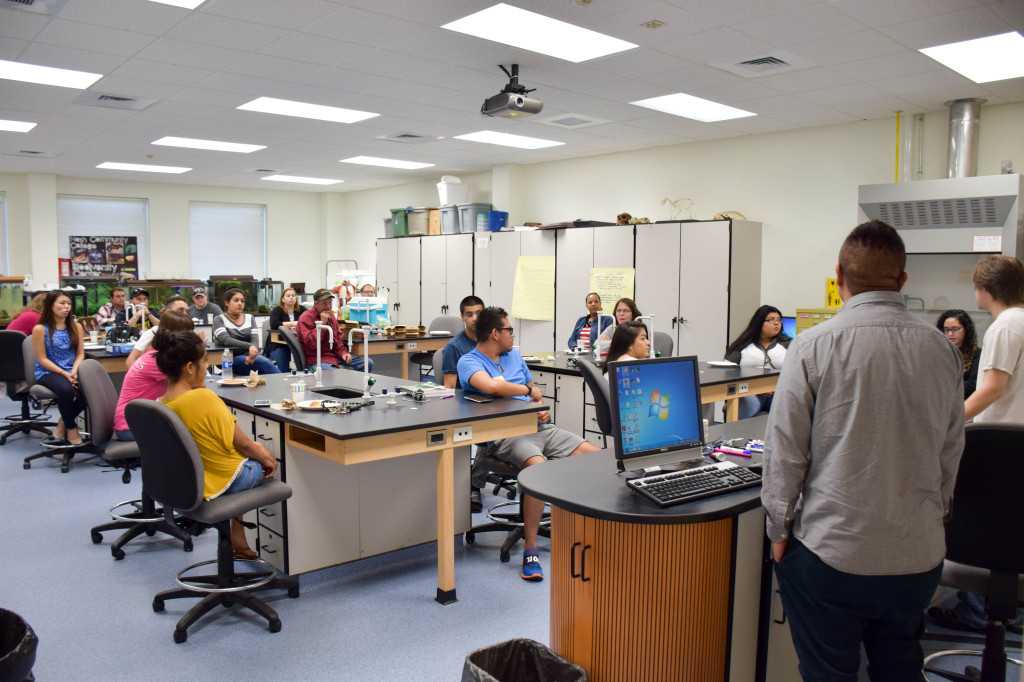STEM-based research gives Nash Community College students a boost in educational achievement
 With the aid of a Duke Energy Water Resources grant, Nash Community College students in rural eastern North Carolina are performing graduate level research. These students are preparing for, and successfully transferring to, major research centers at area universities and taking firsthand experience with them.
With the aid of a Duke Energy Water Resources grant, Nash Community College students in rural eastern North Carolina are performing graduate level research. These students are preparing for, and successfully transferring to, major research centers at area universities and taking firsthand experience with them.
North Carolina’s Neuse and Tar River basins and main tributaries are home to a unique species of salamander: the Neuse River waterdog. In the late 1970s, biologists from the North Carolina Natural History Museum conducted surveys throughout the Neuse and Tar River drainages and found the waterdogs to be moderately abundant in most stretches.
However, that is not the case today. Since many streams have been impacted by runoff and pollution, biologists are concerned about the waterdog population status. For this reason, the North Carolina Wildlife Resources Commission (NCWRC) sought to re-survey as many of the sites as possible that were sampled in the 1970s.
To make the results comparable with the previous data, identical protocol was followed. The data collected was entered and submitted to North Carolina Wildlife Resources Commission biologists.
The Neuse River waterdog is a completely aquatic salamander with feathery gills on each side of its head. Large adults are less than 12 inches in length from the tip of the nose to the tip of the tail. They are brown with black spots and four toes on each of four feet, with a flat paddle-like tail that aids in swimming. Neuse River waterdogs are active at night and very unlikely to be seen by people without the implementation of special techniques to find the creatures. They are currently a candidate for federal endangered species listing mainly due to their sensitivity to environmental conditions.
Nash Community College (NCC) students began surveying Neuse River waterdogs for the North Carolina Wildlife Resources Commission study in 2011. They deployed baited traps in various North Carolina streams to study populations in Nash, Edgecombe, Wake, Franklin, and Wilson counties. The College is located in Rocky Mount, North Carolina, near the intersection of Interstates 95 and 495 in eastern North Carolina.
Nathaniel Akers, who graduated from Nash Community College in May 2014 and assisted in the development of the College’s Biodiversity Center says of his experience with the study, “I developed many skills through my research at Nash Community College, and many people from other universities and organizations are always interested to hear about my scholarly experiences at the community college.”
Akers was among the first cohort of students to participate in the waterdog research during the data collection phase which aims to support the conservation of a species of great concern in North Carolina. Upon graduation, he transferred to the University of North Carolina at Wilmington where his research examined the zonation in salt marshes. “While at NCC, I traveled and developed lab skills that made me a competitive candidate for internships and lab positions at the University of North Carolina at Wilmington – opportunities that are hard to come by for undergraduates at four-year universities. Many professors were impressed that I was able to gain so many skills and experiences so early in my studies.” A University of North Carolina at Wilmington graduate, Akers is employed as Conservation and Research Technician at the North Carolina Aquarium at Fort Fisher.
The Duke Energy Water Resources Fund grant has extended the waterdog research creating the Water Quality Institute. The $99,850 Duke Energy grant enabled the establishment of the Institute on the community college campus to improve water quality and conservation in the Neuse and Tar-Pamlico river basins through research, public outreach, K-14 education and workforce development.
NCC’s Water Quality Institute is conducting research to assess the relative impact of different land uses and invasive species dynamics on aquatic systems and endemic organisms of these river basins. The initial analysis of the data collected resulted in a map of the basins showing land use, invasive species, water quality, and the presence of the endemic waterdog making it possible for NCC Biology class lab work to conduct samplings and analyze change documentation over time.
The presence of an endemic species provides valuable information about the health of its environment. Following the field research for the NC Wildlife Resources Commission, the grant allows the identification of the Environmental DNA (eDNA) signature of the Neuse River waterdog. This has resulted in better means for tracking and recording evidence of the elusive salamander.
The data collected by the program has not only been provided to the North Carolina Wildlife Resources Commission, NC Department of Energy and Natural Resources, and other agencies and organizations, but NCC faculty have distributed findings among scientists and conservation specialists. Faculty and students have shared the findings through conference presentations with plans for submission to peer-reviewed scientific journals.
Nearly 90 students in the laboratory sections of NCC Biology courses have participated in data collection and analysis, exposing them to water quality science, land management, and species richness. Students are receiving hands-on education and applied pedagogy on critical environmental issues impacting the quality of natural waters and endemic species.
Three NCC Biology students completed next generation ribonucleic acid (RNA) extraction at Florida State University. One of which was Ismael Gomez who graduated from NCC in May 2016. He said his research experiences at Nash prepared him for his paid internship at East Carolina University Brody School of Medicine as the only community college graduate among nine interns. At ECU he examined the implications a rat protein could have on the treatment of Alzheimer’s disease. Gomez is currently enrolled in the Bachelor of Science in Biology program at the University of North Carolina at Chapel Hill where he is minoring in Chemistry.
The RNA extractions from Florida State were submitted to the Georgia Genomic Facility at the University of Georgia where libraries were prepared before Hi-Seq next generation sequencing was completed at Florida State University. At East Carolina University the transcriptome of the student’s research was assembled and sent back to Florida where the transcriptome was used to design probes specific to waterdogs.
Duke Energy’s investment at Nash Community College has enabled the Water Quality Institute to purchase equipment such as a StepOnePlus Real-Time PCR System providing precise, intuitive, quantitative data analysis and instrument control software for genomic research. Additionally with the funding, the Institute has ordered specific probes – small strands of DNA that match the water dog DNA – identified through the sequencing project.
The probes are helpful in detecting the presence of waterdogs in the area by detecting their DNA in turbid water without ever actually seeing the animals. In addition to the implications the findings have on environmental research, the Nash Community College Water Quality Institute’s future projects could include establishing a Junior Water Quality Program, summer STEM camps for middle school students, training for developers and landowners, and a Neuse River waterdog exhibit at the Rocky Mount Brewmill, located beside the Tar River.
This body of knowledge will help students understand the impact human activities have on water quality, and become ambassadors of biology, sharing their experiences with family, friends and scholarly audiences.
Nash Community College was founded in 1967 and is part of the North Carolina Community College System. For more information, visit www.nashcc.edu.









